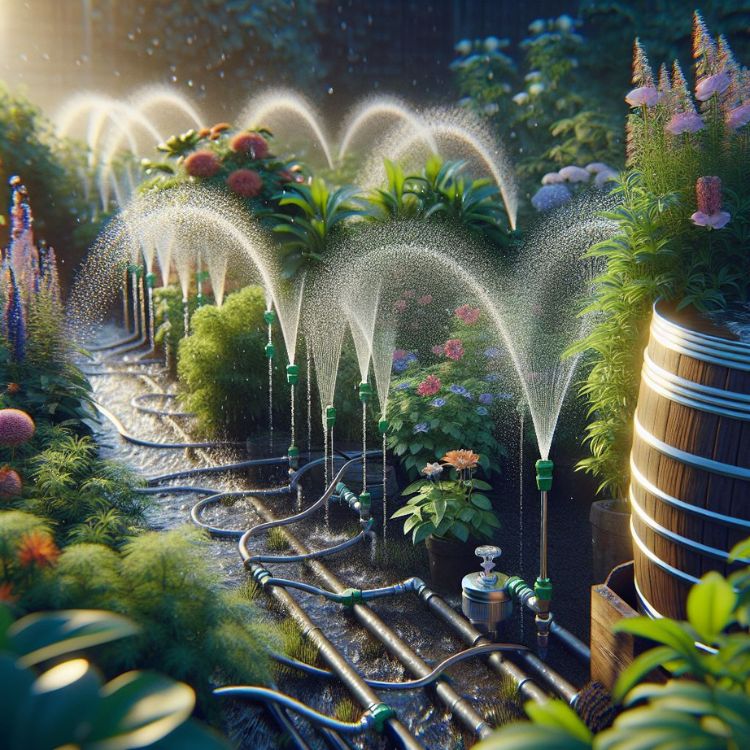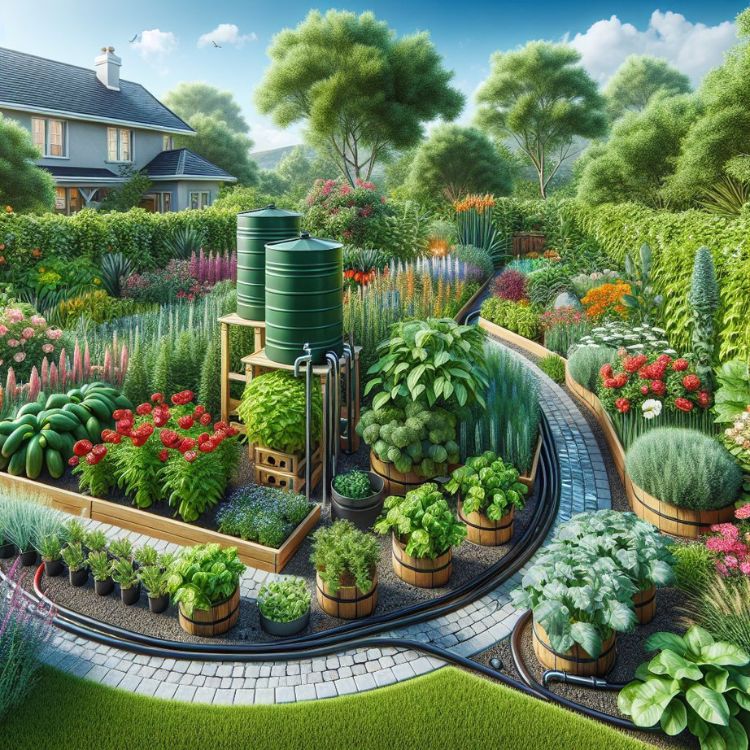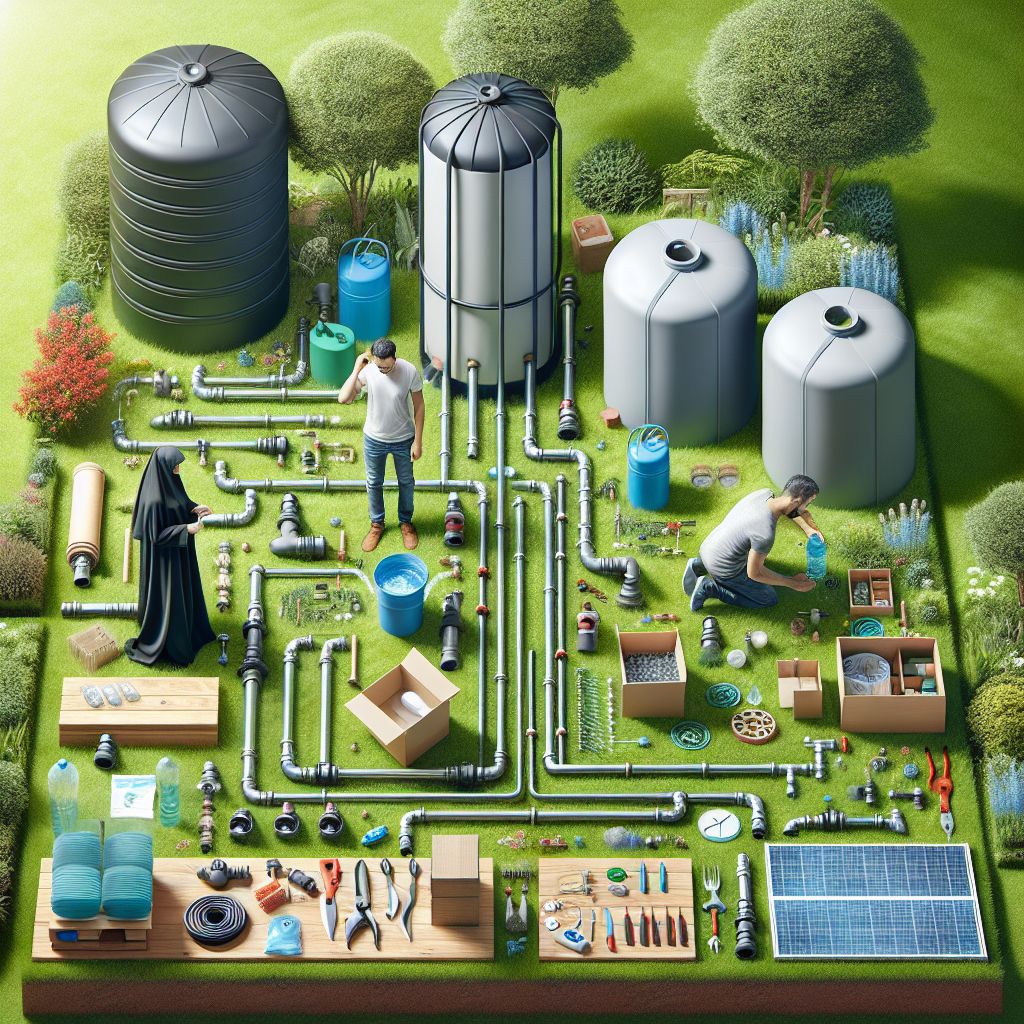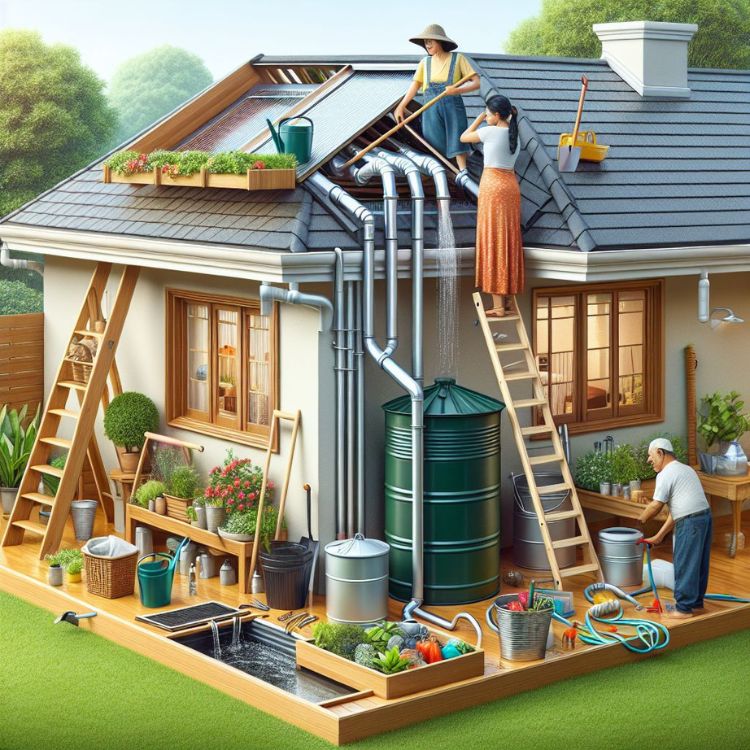
Key Takeaways
- Rainwater harvesting is an efficient way to sustain your garden, reducing reliance on municipal water and cutting costs.
- Assess your garden’s water needs and plan your rainwater harvesting system accordingly to maximize efficiency.
- Use simple materials like gutters, barrels, and filters to set up a rainwater collection system that’s both effective and environmentally friendly.
- Keep your stored water clean with regular maintenance, and take steps to prevent algae growth and mosquito breeding.
- Stay informed about local regulations regarding rainwater harvesting to ensure your system is compliant with laws and building codes.
Why Rainwater Harvesting is a Game-Changer for Your Garden

Imagine your garden thriving, lush and green, even in the driest months, without running up a huge water bill. That’s the power of rainwater harvesting. By capturing and using rainwater, you can maintain a bountiful garden and contribute to a healthier planet. Plus, it’s a step towards self-sufficiency that can be incredibly satisfying.
The Basics of Rainwater Harvesting
At its core, rainwater harvesting is about collecting and storing rain for later use. It’s a simple concept with a big impact. You’ll need a catchment area, like your roof, and a way to channel that water into storage containers. The beauty of this system is its simplicity and adaptability for gardens of all sizes.
Environmental and Financial Benefits
Harvesting rainwater isn’t just good for your plants; it’s good for the planet and your wallet. By using rainwater, you reduce the demand on municipal water supplies and minimize runoff that can cause erosion and water pollution. Financially, it can significantly lower your water bills, especially during peak gardening seasons when watering needs are highest.
Planning Your Rainwater Harvesting Setup

Before you start collecting rainwater, you’ll want to make a plan. This means understanding your garden’s water needs and the amount of rainfall your area receives. A well-planned system ensures you have enough water when you need it and don’t waste resources on unnecessary storage.
Assessing Your Garden’s Water Needs
Every garden is different. To figure out how much water you’ll need, consider the size of your garden, the types of plants you’re growing, and your local climate. A simple rule of thumb is that most gardens need about 1 inch of water per week. From there, you can calculate the volume of water your garden will use.
Choosing the Right Location for Collection
The best spot for collecting rainwater is usually from your roof via gutters. You’ll want to ensure your gutters are clean and directing water efficiently into your storage system. The location should be easily accessible for maintenance and close enough to your garden for easy watering.
Most importantly, consider the path the water will take from your roof to your storage container. A direct, unobstructed route will ensure maximum collection efficiency.
Calculating Storage Capacity Requirements
How much rainwater you can collect depends on the catchment area and the average rainfall in your region. Here’s a simple formula to estimate your collection potential: Multiply the square footage of your catchment area by the rainfall in inches, then multiply by 0.623 to convert to gallons.
For example, if you have a 1,000 square foot roof and your area gets 10 inches of rain annually, you could potentially collect 6,230 gallons of water a year.
Building a Rainwater Harvesting System
Materials You’ll Need
To get started, you’ll gather a few key materials. You’ll need gutters and downspouts for your roof, a storage tank or rain barrel, a first-flush diverter to ensure cleanliness, and screens to keep out debris and insects. Additionally, consider a stand for your barrel to increase gravity flow and hoses or drip irrigation lines to distribute the water to your garden.
Step-by-Step Installation Guide
Installing your rainwater harvesting system is a straightforward process. First, attach gutters to the edge of your roof, sloping them slightly towards the downspout location. Next, connect the downspout to your first-flush diverter, which should then lead to your storage container. Make sure to cover the container with a tight-fitting lid and a screen to keep out unwanted visitors and debris.
DIY Tips for Sustainable Systems
When building your system, use materials that can withstand the elements and won’t leach chemicals into your water. Opt for food-grade barrels or BPA-free plastics for safe water storage. You can also paint your containers with non-toxic paint to protect against UV damage and to help them blend in with your garden’s aesthetic.
Keeping Your Stored Water Safe and Clean
Filtering and Purification Best Practices
For water that’s safe for your plants, a good filtration system is key. Use a mesh screen to catch debris at the downspout entry. For finer filtration, consider adding a layer of activated charcoal or a sand filter to remove smaller particles and contaminants. Remember, clean water means healthy plants.
Preventing Algae and Mosquitoes
Algae growth and mosquitoes can be a problem in standing water. To prevent this, keep your water moving with a small pump or use a tight-fitting lid to block sunlight and deny mosquito access. You can also add a few drops of non-toxic oil to the surface of the water to create a barrier against these pests.
Maintaining Your Rainwater Harvesting System.

Regular Check-Ups and Cleaning
Like any garden tool, your rainwater harvesting system requires maintenance. Inspect and clean your gutters regularly, especially after storms. Every few months, check your storage containers for sediment and flush your system to keep it running smoothly. This will ensure you’re always ready to collect rain when it comes.
- Clean gutters and downspouts to prevent blockages.
- Inspect your storage tanks for leaks or damage.
- Flush your system periodically to remove any sediment.
Winterizing Your System
In colder climates, it’s important to prepare your system for winter. Drain your tanks to prevent freezing and damage. Detach and store hoses to prevent cracking. And if possible, redirect your downspouts away from the storage system to prevent ice build-up.
Legal Considerations and Compliance
Understanding Local Regulations
Before you begin collecting rainwater, it’s crucial to understand the laws in your area. Some regions have specific regulations about rainwater harvesting, so check with your local government to avoid any legal issues. Compliance is key to a hassle-free rainwater harvesting experience.
Permits and Building Codes
You might need permits for your rainwater harvesting system, especially if it’s a large setup. Ensure your system adheres to local building codes, which may dictate how you can collect and use rainwater. Taking the time to get this right at the start can save you from potential headaches down the road.
Maximizing Your Garden’s Potential with Harvested Rainwater
Irrigation Strategies for Different Plant Types
Using harvested rainwater wisely means understanding the needs of your plants. Some plants thrive with a good soaking once a week, while others prefer a more frequent, gentle spray. Drip irrigation systems are great for slow, consistent watering that targets the roots directly, minimizing waste.
Mulching and Soil Health with Rainwater
Pairing rainwater harvesting with mulching can do wonders for your garden. Mulch helps retain moisture, reducing the need for frequent watering. It also keeps the soil temperature stable and adds nutrients as it breaks down. Together with rainwater, mulch creates a thriving environment for your plants.
FAQs
How Much Rainwater Can I Realistically Collect?
The amount of rainwater you can collect depends on the size of your catchment area and the amount of rainfall. A simple calculation can give you an estimate, but remember, the actual amount can vary based on weather patterns and the efficiency of your system.
What Is the Cost of Setting Up a Rainwater Harvesting System?
The cost can range from a few hundred dollars for a basic setup to several thousand for larger, more complex systems. It usually costs less if you’re able to do the installation yourself and use recycled materials like repurposed barrels or bins.
Is Rainwater Harvesting Worth It for Small Gardens?
Absolutely. Even small gardens can benefit from rainwater harvesting. It reduces your environmental impact and saves money on water bills. Plus, plants love the soft, chemical-free rainwater, which can lead to a healthier garden overall.
Can I Use Harvested Rainwater for Household Purposes?
With proper filtration and purification, harvested rainwater can be used for non-potable household purposes such as flushing toilets or washing clothes. However, for drinking, cooking, or bathing, you should adhere to stricter purification standards and local health regulations.
What Should I Do with Overflow Water?
Design your system with overflow in mind. You can direct excess water into a garden bed, create a rain garden to absorb the extra water, or use it to recharge groundwater. This way, you make the most of every drop, even when your storage is full.
Harvesting rainwater is a sustainable step forward in maintaining your garden. It’s about being resourceful, eco-friendly, and creating a lush landscape that can withstand the ebbs and flows of natural water availability. Whether you’re a seasoned gardener or just starting, rainwater harvesting is an essential component of a survival garden, ensuring your green space remains resilient and bountiful year-round.
Implementing a rainwater harvesting system for your garden is not just a smart move for sustainability; it’s also a financially savvy decision. With the right setup, you can significantly reduce your reliance on municipal water supplies, leading to lower utility bills. Moreover, by using rainwater, you’re providing your plants with a natural water source, free from the chemicals and treatments often found in tap water.
Maximizing Your Garden’s Potential with Harvested Rainwater
Using harvested rainwater efficiently can transform your garden into a self-reliant oasis. By tailoring your irrigation strategies to the specific needs of your plants and using mulch to conserve moisture, you’ll create an environment where your plants can thrive on nature’s schedule.
Irrigation Strategies for Different Plant Types
Different plants have unique watering needs, and harvested rainwater allows you to meet these needs without waste. For example, vegetables might require more
- Rainwater harvesting is an efficient way to sustain your garden, reducing reliance on municipal water and cutting costs.
- Assess your garden’s water needs and plan your rainwater harvesting system accordingly to maximize efficiency.
- Use simple materials like gutters, barrels, and filters to set up a rainwater collection system that’s both effective and environmentally friendly.
- Keep your stored water clean with regular maintenance, and take steps to prevent algae growth and mosquito breeding.
- Stay informed about local regulations regarding rainwater harvesting to ensure your system is compliant with laws and building codes.
Harvesting rainwater is a sustainable step forward in maintaining your garden. It’s about being resourceful, eco-friendly, and creating a lush landscape that can withstand the ebbs and flows of natural water availability. Whether you’re a seasoned gardener or just starting, rainwater harvesting is an essential component of a survival garden, ensuring your green space remains resilient and bountiful year-round.
Implementing a rainwater harvesting system for your garden is not just a smart move for sustainability; it’s also a financially savvy decision. With the right setup, you can significantly reduce your reliance on municipal water supplies, leading to lower utility bills. Moreover, by using rainwater, you’re providing your plants with a natural water source, free from the chemicals and treatments often found in tap water.
Maximizing Your Garden’s Potential with Harvested Rainwater
Using harvested rainwater efficiently can transform your garden into a self-reliant oasis. By tailoring your irrigation strategies to the specific needs of your plants and using mulch to conserve moisture, you’ll create an environment where your plants can thrive on nature’s schedule.
Irrigation Strategies for Different Plant Types
Different plants have unique watering needs, and harvested rainwater allows you to meet these needs without waste. For example, vegetables might require more frequent watering than native plants or shrubs. Drip irrigation systems are perfect for a targeted approach, ensuring each plant gets just the right amount of water without excess runoff.
Consider the following when planning your irrigation:
- Vegetables and annuals often need water at their roots, making drip irrigation or soaker hoses ideal.
- Trees and shrubs may benefit from deeper, less frequent watering to encourage strong root growth.
- Succulents and drought-tolerant plants require minimal watering and can often subsist on rainwater alone.
Remember, overwatering can be just as harmful as under-watering. Use rainwater wisely to promote healthy growth and prevent waterlogging or root rot.
Mulching and Soil Health with Rainwater
Mulching is a gardener’s best friend when it comes to conserving water. It reduces evaporation, keeps soil temperatures stable, and adds organic matter as it breaks down. When you combine mulching with rainwater harvesting, you’re doubling down on sustainability and soil health.
Here’s how to make the most of mulching with harvested rainwater:
- Choose organic mulch like straw, wood chips, or leaves to add nutrients to the soil.
- Apply mulch around the base of plants to retain moisture and suppress weeds.
- Water your plants at the base to reduce water loss and ensure that the moisture reaches the roots.
Together, mulching and rainwater harvesting create a micro-ecosystem in your garden that supports robust plant growth and vibrant health.
FAQs
How Much Rainwater Can I Realistically Collect?
The amount of rainwater you can collect depends on the size of your catchment area and the amount of rainfall. A simple calculation can give you an estimate, but remember, the actual amount can vary based on weather patterns and the efficiency of your system.
For instance, if you have a 500 square foot roof and receive an average of 30 inches of rain annually, you could collect up to 9,345 gallons of water each year, using the formula: (500 x 30 x 0.623).
- 500 square feet (catchment area)
- 30 inches of rain (annual average)
- 9,345 gallons (potential collection)
What Is the Cost of Setting Up a Rainwater Harvesting System?
The cost can range from a few hundred dollars for a basic setup to several thousand for larger, more complex systems. It usually costs less if you’re able to do the installation yourself and use recycled materials like repurposed barrels or bins.
For example, a simple rain barrel system might cost as little as $50 if you’re using a recycled container and doing the work yourself. A more extensive system with multiple barrels, a first-flush diverter, and a pump could run a few hundred dollars.
Is Rainwater Harvesting Worth It for Small Gardens?
Absolutely. Even small gardens can benefit from rainwater harvesting. It reduces your environmental impact and saves money on water bills. Plus, plants love the soft, chemical-free rainwater, which can lead to a healthier garden overall.
Consider this: even a single rain barrel can provide enough water to keep a small garden thriving through dry spells, making it a worthwhile investment for gardeners of all scales.
Can I Use Harvested Rainwater for Household Purposes?
With proper filtration and purification, harvested rainwater can be used for non-potable household purposes such as flushing toilets or washing clothes. However, for drinking, cooking, or bathing, you should adhere to stricter purification standards and local health regulations.
For instance, using rainwater to wash your car or water indoor plants is a great way to extend its use beyond the garden.
What Should I Do with Overflow Water?
Design your system with overflow in mind. You can direct excess water into a garden bed, create a rain garden to absorb the extra water, or use it to recharge groundwater. This way, you make the most of every drop, even when your storage is full.
An example of managing overflow is to connect a hose to the overflow valve of your rain barrel, directing the water to a thirsty part of your garden or a nearby pond.
Harvesting rainwater is a sustainable step forward in maintaining your garden. It’s about being resourceful, eco-friendly, and creating a lush landscape that can withstand the ebbs and flows of natural water availability. Whether you’re a seasoned gardener or just starting, rainwater harvesting is an essential component of a survival garden, ensuring your green space remains resilient and bountiful year-round.






